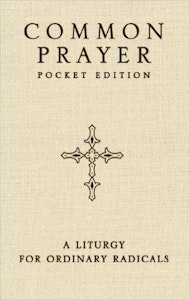Introductory Note:
I don’t think I ever heard the word “liturgy” in the Baptist church of my youth, but of course we had one, as informal and unstated as it was. “Liturgy” means, simply, “the work of the people”—it includes both the form and the substance of the things we do whenever we gather together to meet with God and tell his story.
In recent years, I’ve discovered some of the treasures to be found in more formal and historical liturgies—the beautiful language, the accrued meaning of repeated ritual, the importance of allowing the believers who have gone before us to have a say in our worship now. Like any adult convert to a new way of worship, I’ve been rather enthusiastic about my new (in this case, ancient) discoveries, and perhaps a bit dismissive of the old (more modern) forms of worship that so defined my past.
I need this short, punchy piece from Common Prayer: A Liturgy for Ordinary Radicals, to remind me that the “work of the people” is a big enough project to require both the formal and the spontaneous. Whether we meet in cathedrals or gymnasiums (or anything in between), the important question is whether our worship “moves us closer to God and to our suffering neighbor.”
Carolyn Arends
Director of Education, Renovaré
 Excerpt from Common Prayer Pocket Edition
Excerpt from Common Prayer Pocket Edition
We must be careful in all our talk about liturgical prayer not to rule out the spontaneous moves of the Spirit. Just as liturgical traditions have much to offer us by way of roots, the charismatic and Pentecostals have much to offer us in zeal and passion. Tradition and innovation go together in God’s kingdom. Jesus was Jewish. He went to synagogue “as was his tradition” and celebrated holy days such as Passover. But Jesus also healed on the Sabbath. Jesus points us to a God who is able to work within institutions and order, a God who is too big to be confined.
God is constantly coloring outside the lines. Jesus challenges the structures that oppress and exclude, and busts through any traditions that put limitations on love. Love cannot be harnessed.
Liturgy is public poetry and art. You can make beautiful art by splashing paint on a wall, and you can also make art with the careful diligence of a sculptor. Both can be lovely, and both can be ugly. Both can be marketed and robbed of their original touch, and both have the potential to inspire and move people to do something beautiful for God.
So it is with worship. More important than whether something is old or new, winsome or classic is whether it is real. The Scriptures tell us to “test the spirits,” and the true test of the spirit of a thing is whether it moves us closer to God and to our suffering neighbor. Does it have fruit outside of our own good feelings?
Beauty must hearken to something beyond us. It should cause us to do something beautiful for God in the world.
Excerpted from Common Prayer Pocket Edition: A Liturgy for Ordinary Radicals by Shane Claiborn, Jonathan Wilson-Hartgrave, and Enuma Okoro (New York; HarperCollins-Zondervan, 2012), pp. 175 – 176.




